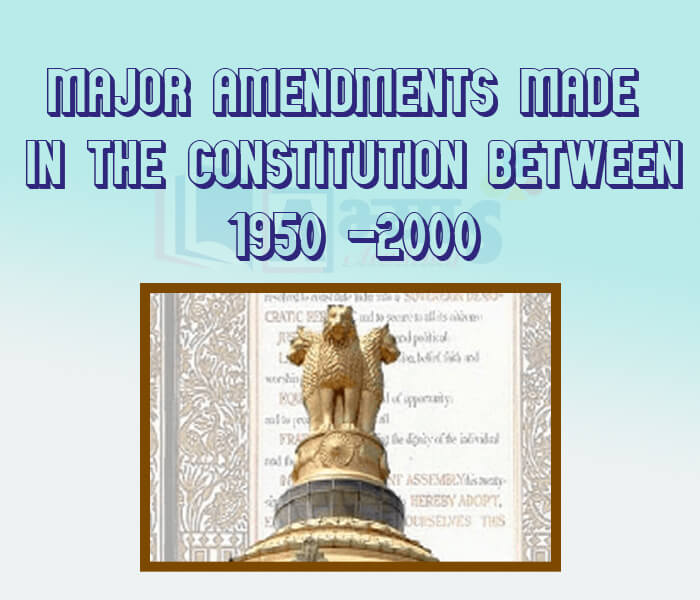Major Amendments Made in The Constitution Between 1950 -2000











Major Amendment Made in the Constitution Between 1950-2000
First Amendment (1951 AD) -
Though this, an attempt was made to remove some practical difficulties related to the enforcement of Fundamental Rights related to freedom, equality and property. Also, the Ninth Schedule was added to the Constitution by this amendment, in which the mentioned laws cannot be tested under the powers of judicial review of the Supreme Court.
Third Amendment (1954 AD) -
Under this amendment Seventh Schedule to the Constitution for entry 33 of Concurrent List, following entry shall be substituted namely, fodder for animals, raw cotton, jute, etc, whose production and supply is understood in the public interest and can control it.
Seventh Amendment (1956 AD) -
States were reorganized on linguistic basis by this amendment, eliminating the classification of states in A, B, C, and introduction of union territories. Also, according to it, the seats in the Central and State Legislatures were rearranged
Eighth Amendment (1959 AD) -
Under this, the provisions related to reservation of Scheduled Castes, Scheduled Tribes and Anglo-Indian communities in the Lower Houses of the Centre and States were extended for ten years i.e from 1970 AD.
Which of the following are correct : (a) In 24th Amendment, a new state of Tripura was carved out of Assam in the northeast. (b) Under 26th Amendment, special titles of rulers of former indigenous states and their privy-purses were abolished. | |||
| Right Option : B | |||
| View Explanation | |||
Which of the following are correct : (a) Under the Amendment 35th, the status of the protected state of Sikkim by India was abolished and allowed to enter India as an allied state. (b) By 53th amendment the Union Territory of Mizoram was given the status of 23rd state of India. (c) By the 69th Amendment, two new Articles in the Constitution, Article 239AA and 239AB were been added. | |||
| Right Option : D | |||
| View Explanation | |||
The first amendment of the Constitution passed in the year 1951 was related to which of the following ? | |||
| Right Option : C | |||
| View Explanation | |||
Students / Parents Reviews [10]
I have spent a wonderful time in Abhyas academy. It has made my reasoning more apt, English more stronger and Maths an interesting subject for me. It has given me a habbit of self studying

Yatharthi Sharma
10thA marvelous experience with Abhyas. I am glad to share that my ward has achieved more than enough at the Ambala ABHYAS centre. Years have passed on and more and more he has gained. May the centre flourish and develop day by day by the grace of God.

Archit Segal
7thBeing a parent, I saw my daughter improvement in her studies by seeing a good result in all day to day compititive exam TMO, NSO, IEO etc and as well as studies. I have got a fruitful result from my daughter.

Prisha Gupta
8thMy experience with Abhyas is very good. I have learnt many things here like vedic maths and reasoning also. Teachers here first take our doubts and then there are assignments to verify our weak points.

Shivam Rana
7thAbout Abhyas metholodology the teachers are very nice and hardworking toward students.The Centre Head Mrs Anu Sethi is also a brilliant teacher.Abhyas has taught me how to overcome problems and has always taken my doubts and suppoeted me.

Shreya Shrivastava
8thIt was good as the experience because as we had come here we had been improved in a such envirnment created here.Extra is taught which is beneficial for future.

Eshan Arora
8thMy experience with Abhyas academy is very good. I did not think that my every subject coming here will be so strong. The main thing is that the online tests had made me learn here more things.

Hiya Gupta
8thOne of the best institutes to develope a child interest in studies.Provides SST and English knowledge also unlike other institutes. Teachers are co operative and friendly online tests andPPT develope practical knowledge also.

Aman Kumar Shrivastava
10thAbhyas Methodology is very good. It is based on according to student and each child manages accordingly to its properly. Methodology has improved the abilities of students to shine them in future.

Manish Kumar
10thMy experience was very good with Abhyas academy. I am studying here from 6th class and I am satisfied by its results in my life. I improved a lot here ahead of school syllabus.
